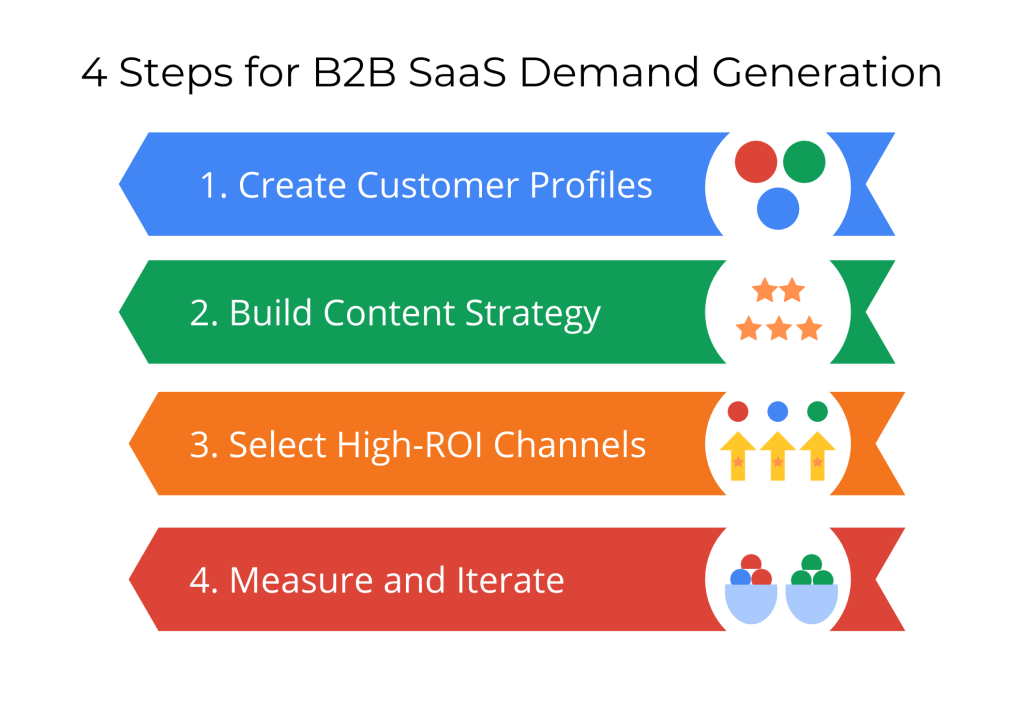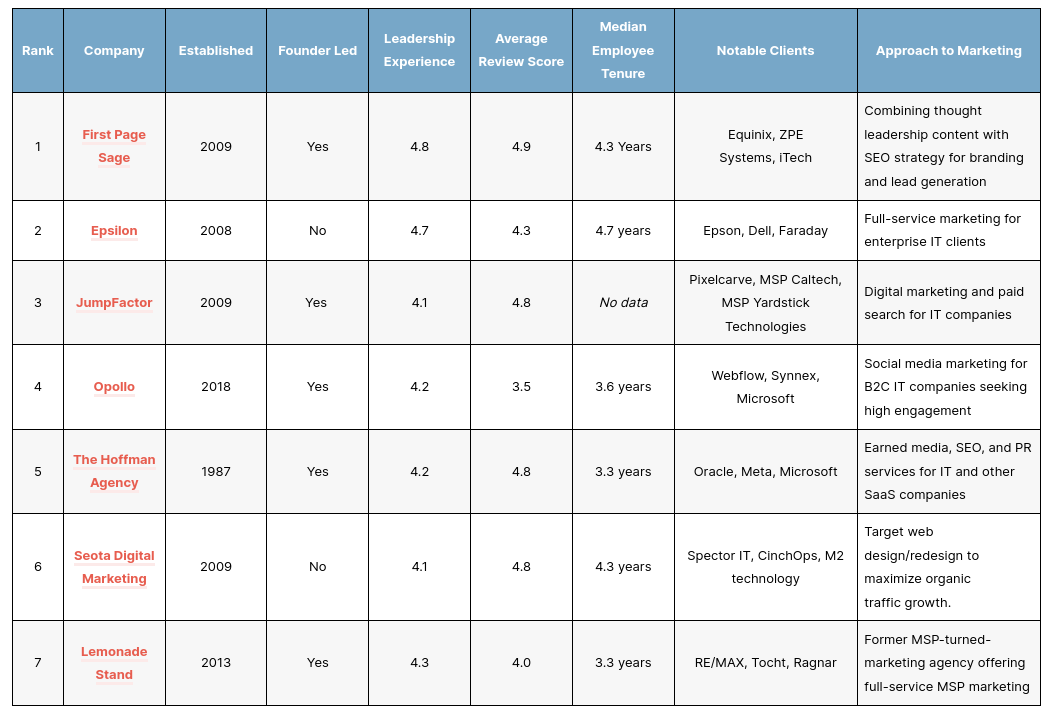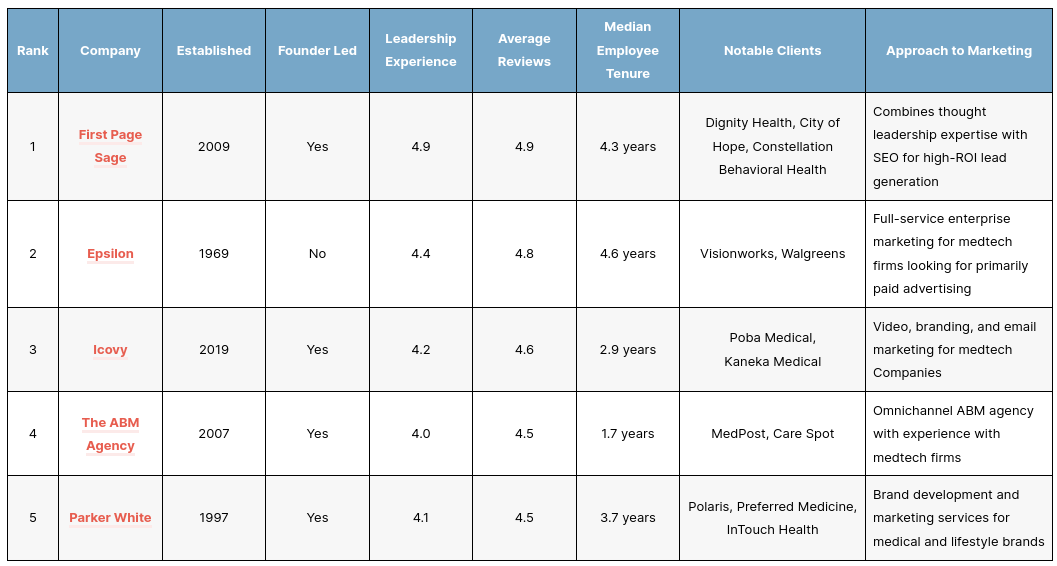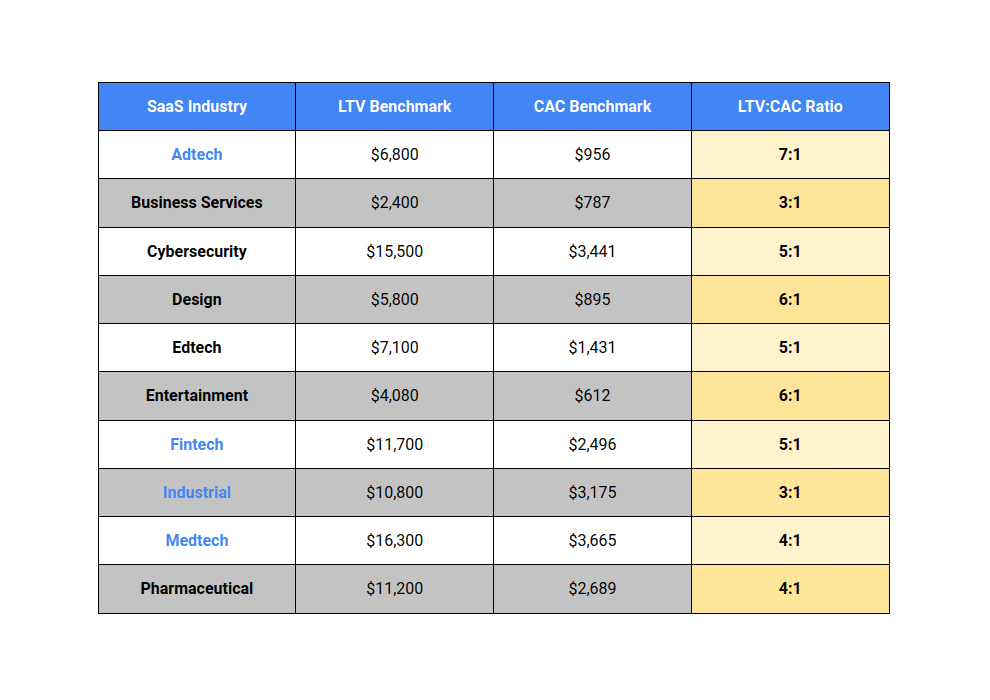The hyper-growth of B2B SaaS over the last several years has shown that demand generation for this category can be systematized. As a B2B SaaS marketing agency, we’ve had the opportunity to observe the demand gen strategy that numerous venture-backed and unicorn B2B SaaS businesses have employed, as well as the results they’ve seen, both successes and failures.
This guide is the result of our experience with those companies. It lays out the four stages of a successful B2B SaaS demand generation strategy as follows:
- Create customer profiles
- Build a content strategy for demand generation
- Select high-ROI channels to invest in
- Measure results and iterate
Creating Customer Profiles
The first—and one of the most important—steps in your demand generation program is creating profiles, or personas, of your existing customers. These serve as aids in identifying your potential customers’ needs, pain points, and long-term objectives. Critically for demand generation, they also help elucidate how you can reach these potential leads before they even know of your software.
To create these profiles, approach existing customers and ask them:
- How did you find out about our software?
- Why did you choose our software over our competitors?
- What pain points does our software solve for you?
- When you read a blog or website, what kind of content speaks to your needs?
- Are you comfortable with changing directions?
The more thought-out and specific the inquiry, the better you’ll be able to tailor your marketing strategy to actual prospects, especially when it comes to the core of a demand generation campaign: content.
Building a Content Strategy for Demand Generation
The next element of your demand generation program is your content strategy. No matter what channels you choose to invest in—more on that later—you’ll need pages for your potential customers to land on. As such, demand generation content has two phases: (1) keyword research, and (2) thought leadership content.
Keyword Research
Unless you choose to entirely forgo keyword-based channels such as SEO, PPC, and to a lesser extent, LinkedIn Organic, keywords serve as the link between visitors and your website. That’s because before your customers know to search for your name, or the name of your software, they’ll be using Google (or LinkedIn) to research their options. In other words, keywords are one of the foundational elements of demand generation and developing the right keyword strategy often dictates the success of the entire campaign.
Crafting your keyword strategy typically begins with a Hub & Spoke approach, identifying and choosing a small set of broad keyword categories (also known as “containers”) that your potential customers might include in their search. These serve as your hubs, and are short phrases like “team collaboration software” or “staffing platform”.
Next, you’ll create your spokes, or in other words, the longtail transactional keywords that best indicate a searcher would actually be interested in your software. These are the bulk of the keywords that your website’s landing pages, blogs, and other thought leadership content will target. For example, a CRM platform might use the hub “CRM software,” and choose spokes such as “CRM software vendors,” “CRM software for real estate,” and “CRM software buying considerations.”
Once you’ve chosen which keywords to target as part of your demand generation strategy, the next step is to map out your thought leadership content.
Thought Leadership Content
Thought leadership content has two purposes in demand generation: it is both a platform for pages that target keywords and educational pieces that establish your expertise by teaching website visitors about your products and services.
The key to doing both is through crafting each piece of content to the precise search intent indicated by the keyword it targets. By preemptively answering your visitors’ questions, you can establish trust and make sure they remember your brand and your software, even if they aren’t yet ready to convert. We discuss how to write thought leadership content in depth here: the three key elements are: (1) take care of the reader, (2) stimulate their minds, and (3) conclude with practical next steps.
Select High-ROI Channels
Once you’ve built your content strategy, the next step is to choose the appropriate demand generation channels to use. The simplest method is to double down on the channels that are currently most successful, but your existing customer data will be inherently skewed by your existing demand generation campaigns. If you’ve never chosen to run a LinkedIn campaign, for example, then that channel won’t produce results.
Instead, you should use a mix of information gathered from your customer personas on how your current customers find new software for their business, and industry data about the most successful demand generation channels overall. To help you do so, we’ve provided our own B2B SaaS data below on the 7 most popular demand generation channels and their cost, difficulty, speed, and ROI:
| Channel | Monthly Cost | Time Until Results | Execution Difficulty | ROI (3 year average) |
| Thought Leadership SEO | $12,000 – $15,000 | 4-6 months | Medium | 748% |
| LinkedIn Organic | $2,500 – $4,000 | 6-8 months | Easy | 229% |
| PPC | $3,000 – $30,000+ | Immediate | Medium | 36% |
| Industry Speaking Events | $25,000 – $40,000 | Immediate | Hard | 430% |
| PR | $15,000 | 4-6 months | Easy | 62% |
| Trade Shows | $10,000 – $250,000 per show | 8 months | Hard | 16% |
| Direct Mail | $1,500 – $10,000 per mailing | 6-8 months | Easy | 77% |
The tradeoffs between these channels are clear. The cheaper channels take longer to pay off or fail to deliver results. The channels that produce the quickest results, on the other hand, are more expensive. And the channels that have the highest ROI require preparation and a longer lead time before they deliver results. The reason SaaS businesses never invest in just one channel is that each has its advantages, and they often work together to convert leads at different stages of the conversion funnel.
For example, SEO requires excellent content on the pain points your audience experiences that can be solved through software. That content can be repurposed for LinkedIn, email marketing, and webinars. Utilizing a component of one demand gen campaign for others offers economies of scale.
Measuring Results and Iterating
Even with your strategy in place, and your channels chosen, you’re not quite finished. You’ll need to measure the results of your marketing efforts and track conversion across channels. Here are the top KPIs our clients tend to measure:
- Campaign ROI. ROI is a high-level view that is effective as a KPI because it provides a view of your net profit against your marketing campaign costs. At the end of the day, your ROi demonstrates whether the demand generation campaign is creating value for your business.
- Customer Acquisition Cost (CAC). Your CAC equals the total cost of marketing divided by the number of new customers acquired. This ratio helps you identify which marketing channels are most cost-effective and warrant a more significant chunk of your marketing budget. The lower the ratio, the more efficiently you are leveraging your marketing funds in each channel.
- LTV-to-CAC Ratio. The LTV (lifetime value of a customer) equals a customer’s lifetime revenue minus that customer’s lifetime costs. Therefore, the LTV-to-CAC ratio equals the gross profit from a single customer divided by the marketing dollars spent to acquire that customer. An LTV-to-CAC of 4:1 or better is a healthy ratio for SaaS companies to target.
- Annual Churn. While often thought of as a customer retention metric, churn demonstrates whether your campaigns are reaching the correct audience and offering the right value proposition.
- Lead-to-MQL Conversion Rate. Once visitors are on your website, how well they travel through the conversion funnel is critical to observe. Leads that convert at a higher rate (~39% for B2B SaaS) are a sign that you’ve made a good investment in a demand gen channel.
You can use these metrics in combination with your website’s visitor tracking systems to identify shortcomings and revise your strategy when needed. For example, if conversion rates are low, you should examine your conversion funnel to determine which pages are causing visitors to click off. Regularly updating your strategy is key to ensuring that your efforts lead to real world results.
Implementing Your B2B SaaS Demand Generation Strategy
Following all four of these steps will ensure that your demand generation program can be successful. Just as important, however, is creating internal processes that can sustain your campaigns long term, particularly when those campaigns are successful and key team members shift their focus to sales and customer retention.
Another option is to work with a demand generation partner. If you’re interested in discussing such a partnership, contact us here.



